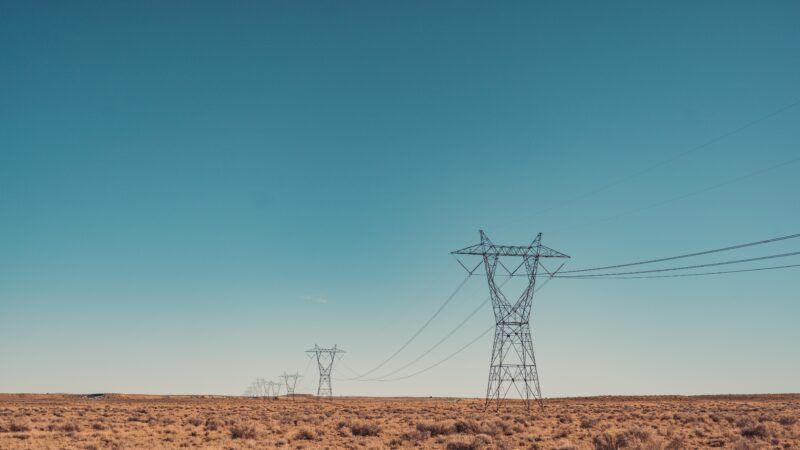It Took 15 Years for the Feds To Approve a 700-Mile Electric Line
It'll be another five years before it's operational.

In November 2007, the original iPhone was barely four months old, Barack Obama was considered a long shot to win the Democratic nomination for president, and Steph Curry was a sophomore playing basketball for little-known Davidson College.
That same month, the TransWest Express Transmission Project filed its first request with the Bureau of Land Management (BLM), seeking permission to build a 732-mile electric transmission line to connect a wind farm in southern Wyoming with a power grid serving the rapidly growing area around Las Vegas.
Last week, the BLM granted permission for the line to be built.
We've blown through 14 versions of iPhones, seen two terms of Obama's presidency (plus another term-and-a-half since he left office), and witnessed Curry score over 21,000 points and win four championships as a professional in the time that it took federal bureaucrats to review and approve an application for a transmission line carrying completely carbon-free, renewable energy across a mostly empty portion of the American West. That's a perfect illustration of the fact that the biggest obstacle to the government's renewable energy goals is often, in fact, the government itself.
Or governments, in this case. While the BLM took longer than anyone else to approve the project, the TransWest Express line suffered from "a 'spider web of jurisdiction' across multiple levels of government," according to Roxane Perruso, the company's COO. Perruso told EnergyWire, a trade publication, that the project required approvals from state, local, and federal entities—and getting those permits required surveys of over 40,000 acres of land for environmental impacts and 60,000 acres of land for cultural impacts.
All that to get permission to build a power line, which is less invasive than other forms of infrastructure can be. In addition to the BLM and state governments of Wyoming, Colorado, Utah, and Nevada, the project needed approval from the U.S. Forest Service, part of the federal Department of Agriculture, and the Western Area Power Administration, which is part of the federal Department of Energy. (In fairness, EnergyWire notes that the project also got snagged by disputes with some private property owners along the planned route.)
With all the permission slips finally locked down, construction on the line will begin later this year, and the 3,000-megawatt line could be operational by 2028, EnergyWire reports. By then, it'll be 23 years since the project was first proposed in 2005.
To put it simply: It should not take nearly a quarter century to build a supply line connecting renewable electric supply with an area where there is growing demand. But this is a recurring problem in America. A recent Princeton study found that 80 percent of the potential emissions reductions from green energy projects funded by the Inflation Reduction Act would be lost without an expansion of transmission lines.
The time and expense of permitting have slowed or prevented some major renewable energy projects in recent years. "Windmills off Cape Cod, a geothermal facility in Nevada, and what could have been the largest solar farm in America have all been blocked by an endless series of environmental reviews and lawsuits," Alec Stapp, a co-founder of the Institute for Progress, which advocates for policies that accelerate technological and industrial progress, wrote last year in The Atlantic. "U.S. climate spending could exceed more than half a trillion dollars by the end of this decade—but without permitting reform, those investments won't translate into much physical infrastructure."
Some of the most serious permitting obstacles are the environmental impact statements required by the National Environmental Policy Act (NEPA), which take 4.5 years on average and run over 650 pages. Sure enough, the environmental impact statement associated with the TransWest Express Line took nearly six years—from January 2011 through December 2016—to be completed. In the statement issued this week by the BLM announcing its final approval of the project, the agency notes that the project will include "mitigation requirements" to offset disruptions "to lands with wilderness characteristics" and impacts to the habitat of the greater sage-grouse, a chicken-sized bird that nests on the ground in the western U.S.
But if reducing carbon emissions and developing green energy are going to be major national objectives, the sage-grouse might just have to get out of the way—or at least be less of a concern. Permitting reforms proposed last year by Sen. Joe Manchin (D–W.Va.) would have capped NEPA environmental reviews at no more than two years in length, but that proposal was decried by prominent progressives as a giveaway to money-grubbing capitalists who want to turn a profit by, well, building the very green energy infrastructure that progressives say America desperately needs.
In March, the Republican-led U.S. House passed a huge energy permitting reform bill that was declared "dead on arrival" by Senate Majority Leader Chuck Schumer (D–N.Y.), though some parts of the bill might be included in an upcoming congressional deal to lift the debt ceiling.
Until there are significant reforms, however, expect future projects like the TransWest Express line to take decades, if not longer. Building big infrastructure projects will never be as simple as turning on a light switch, but there's no reason for the government to force utility companies to operate at the speed of a first-generation iPhone in a 5G world.
